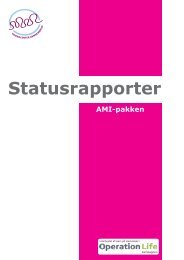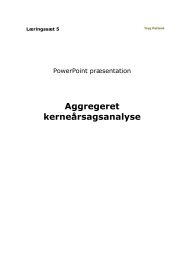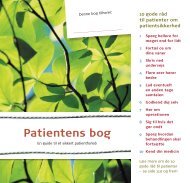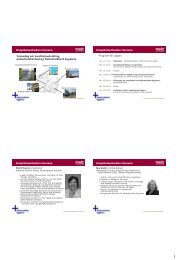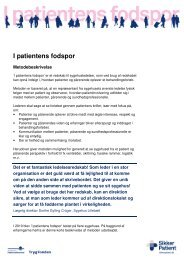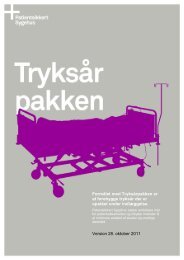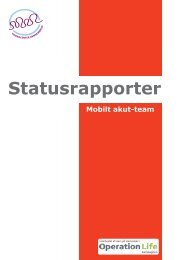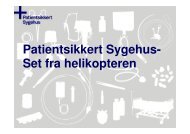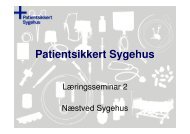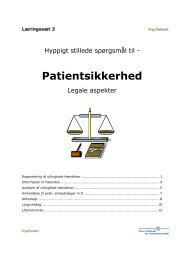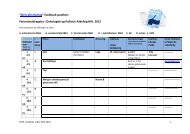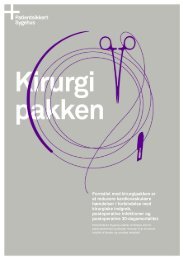IHI Global Trigger Tool - Sikker Patient
IHI Global Trigger Tool - Sikker Patient
IHI Global Trigger Tool - Sikker Patient
You also want an ePaper? Increase the reach of your titles
YUMPU automatically turns print PDFs into web optimized ePapers that Google loves.
<strong>IHI</strong> <strong>Global</strong> <strong>Trigger</strong> <strong>Tool</strong><br />
Frank Federico
Objectives<br />
• Describe how to use data collected using<br />
the <strong>IHI</strong> <strong>Global</strong> <strong>Trigger</strong> <strong>Tool</strong>.<br />
• Discuss the advantages and<br />
disadvantages of different sources of data.
Outline<br />
• Review origin and development of the<br />
trigger tool methodology<br />
• Examine how one organization used the<br />
data<br />
• Review cases
Building a Cascading System of Measures<br />
L 1<br />
Macro Metrics - Outcomes<br />
Structural Measures<br />
Board &<br />
CEO<br />
L 2<br />
Service<br />
Line<br />
L 3<br />
Microsystems: Units, Depts<br />
Meso Metrics – Outcomes +<br />
Processes<br />
Micro Metrics - Processes<br />
Adapted from Lloyd & Caldwell<br />
L 4/ 5<br />
Physician & <strong>Patient</strong><br />
Individual Metrics<br />
- Processes
Background<br />
• Computerized triggers for ADE identification and<br />
concurrent intervention David Classen (1990)<br />
• ADE review identifying 14 triggers accounting for<br />
majority of ADE’s David Classen (1994)<br />
• Adverse drug event trigger tool developed for the<br />
<strong>IHI</strong> Idealized Design of the Medication System<br />
(1999)<br />
• ICU Adverse event trigger tool, <strong>IHI</strong> Idealized Design<br />
ICU (2002)<br />
• <strong>Global</strong> <strong>Trigger</strong> <strong>Tool</strong> testing and spread to US and<br />
international hospitals (2004)
<strong>IHI</strong> Definition of Harm<br />
HARM = Unintended physical injury<br />
resulting from or contributed to by<br />
medical care that requires additional<br />
monitoring, treatment or hospitalization,<br />
or that results in death.
Harm from the <strong>Patient</strong>’s View<br />
• Would you be happy if the event happened to you If the<br />
answer is no, then likely there was harm.<br />
• Was the event part of the natural progression of the disease<br />
process, or a complication of the treatment related to the<br />
disease process The harm identified should be the result<br />
of some medical treatment. The decision is subjective at<br />
times and physician input will be critical.<br />
• Was the event an intended result of the care (e.g., a<br />
permanent scar from surgery) If so, then this is not<br />
considered harm.<br />
• Psychological harm by definition has been excluded as an<br />
adverse event.
Why Use <strong>Trigger</strong> <strong>Tool</strong>s<br />
• Traditional reporting of errors, incidents, or<br />
events does not reliably occur in the best of<br />
cultures in healthcare<br />
• Voluntary methods underestimate events and<br />
concentrate on what is interpreted as being<br />
preventable<br />
• Easily identifies events without complex<br />
technology<br />
• Can be integrated into a good sampling<br />
methodology
Incidents Detected by Three Methods<br />
Olsen, S. et al. Qual Saf Health Care 2007;16:40-44<br />
Copyright ©2007 BMJ Publishing Group Ltd.
Voluntary Reporting<br />
“We found that less than 4% of all adverse drug<br />
events involving use of rescue drugs were<br />
reported.”<br />
Schade, Am J Med Qual. 2006 Sep-Oct;21(5):335-41<br />
Studies of medical services suggest that only 1.5%<br />
of all adverse events result in an incident report.<br />
O'Neil A,. Ann Intern Med 1993;119:370-376)
Accepting the Harm Burden<br />
Adverse Event and Errors<br />
─ “Error” definition bears upon concept of preventability and human<br />
mistake<br />
─ “Adverse event” describes harm to the patient regardless of error<br />
and is often system-based<br />
─ Relationship between errors and adverse events:<br />
Adverse<br />
Events<br />
Errors<br />
Mortality
Adverse Events<br />
Harm and Error<br />
NEW<br />
• Harm is the focus of<br />
discussion<br />
• Looks at all unintended<br />
results<br />
• Measurement is clear<br />
and direct<br />
• Nothing is theoretically<br />
unpreventable<br />
OLD<br />
• Errors and humans are<br />
the focus of discussion<br />
• Tends to focus only on<br />
those outcomes felt to be<br />
related to error<br />
• Measurement relies on<br />
self-reporting<br />
• Many ADEs are seen as<br />
unpreventable
Category of Harm<br />
NCCMERP Index<br />
• E<br />
Temporary harm, intervention required<br />
• F<br />
Temporary harm, initial or prolonged<br />
hospitalization<br />
• G<br />
Permanent patient harm<br />
• H<br />
Life sustaining intervention required<br />
• I<br />
Contributing to Death
<strong>Trigger</strong> Definition<br />
<strong>Trigger</strong>s are defined as occurrences,<br />
prompts, or flags found on review of the<br />
medical record that “trigger” further<br />
investigation to determine the presence or<br />
absence of a medication (medical) error<br />
(adverse event).<br />
Classen DC, Pestotnik SL, Evans RS, Burke JP. Computerized Surveillance of<br />
Adverse Drug Events in Hospital <strong>Patient</strong>s. JAMA 1991;266(20):2847-2851.
Seks moduler<br />
• Generel behandling (15)<br />
• Medicinering (12)<br />
• Kirurgi (16)<br />
• Intensiv behandling (4)<br />
• Perinatale behandling (6)<br />
• Akutmodtagelse (2)
Modul G: Generel behandling<br />
• Transfusion<br />
• Tilkald af stophold m.v.<br />
• Dialyse<br />
• Positiv bloddyrkning<br />
• Røntgen eller ultralyd på<br />
mistanke om lungeemboli<br />
eller DVT<br />
• Pludseligt fald i Hb eller<br />
Hct > 25 %<br />
• Fald<br />
• Tryksår<br />
• Genindlæggelse indenfor<br />
30 dage<br />
• Anvendelse af tvang<br />
• Behandlingsrelaterede<br />
infektioner<br />
• Apopleksi under<br />
indlæggelse<br />
• Overflytning til højere<br />
behandlings- eller<br />
plejeniveau<br />
• Komplikationer<br />
• Øvrigt
Modul M: Medicinering<br />
• C. difficile i<br />
fæcesdyrkning<br />
• APTT > 100 sekunder<br />
• INR > 6<br />
• Glukose < 3 mmol/l<br />
• Stigning i karbamid<br />
eller kreatinin til over<br />
to gange øvre normal<br />
• K-vitamin<br />
• Antihistamin<br />
• Flumazenil<br />
• Naloxon<br />
• Antiemetika<br />
• Hypotension eller<br />
oversedering<br />
• Pludseligt ophør med<br />
lægemidler
Modul K: Kirurgi 1<br />
• Reoperation<br />
• Ændret indgreb<br />
• Postop. indlæggelse<br />
på ITA<br />
• (Re)intubation på<br />
opvågning<br />
• Rtg. på OP eller<br />
opvågning<br />
• Intra- eller<br />
postoperativ død<br />
• Respiratorbehandling<br />
> 24 timer<br />
postoperativt<br />
• Intraoperativ<br />
anvendelse af<br />
adrenalin,<br />
noradrenalin, naloxon<br />
eller flumazenil<br />
• Postoperativ øgning<br />
af troponin-T ≥ 0,1<br />
mikrogram/l
Modul K: Kirurgi 2<br />
• Ændret anæstesiform<br />
under operation<br />
• Tilsyn fra andet<br />
speciale på<br />
opvågning<br />
• Normalt patologisvar<br />
eller anden afvigelse<br />
fra præoperativ<br />
diagnose<br />
• Anlæggelse af<br />
a-kanyle eller cvk<br />
under operation<br />
• Operationstid > 6<br />
timer<br />
• Fjernelse/skade på<br />
organ<br />
• Postoperative<br />
komplikationer
Modul I: Intensiv behandling<br />
• Pneumoni<br />
• Genindlæggelse på ITA<br />
• Behandling/indgreb på ITA<br />
• Intubation/reintubation
Modul P: Perinatale triggere<br />
• Apgar < 7 efter 5 min / pH < 7,05 el. BE > 10 i<br />
navlesnorsblod<br />
• Transport eller overflytning af moder eller barn<br />
• Magnesium eller terbutalin<br />
• 3. eller 4. grads bristninger<br />
• Igangsættelse af fødsel<br />
• Blodsukker < 2,2 mmol/l hos barnet
Modul A: Akut modtagelse<br />
• Genindlæggelse via akutmodtagelsen inden<br />
for 48 timer efter udskrivelse<br />
• Ophold i akutmodtagelsen > 6 timer
Pilot Study<br />
91 adverse events/1000 patient days or<br />
40-50 events per 100 admission<br />
Example: Hospital with 10,000<br />
admissions, with average LOS of 4<br />
days will have approximately 4000<br />
adverse events/year
More recent data…<br />
1450 Adult ICU patients<br />
11.3 AEs per 100 ICU days<br />
2.04 AEs per patient<br />
North Carolina Harm Study
More recent data…<br />
74 Adverse Events per 100 admissions;<br />
56% of all Adverse Events “Preventable”<br />
North Carolina Harm Study
What are we finding<br />
NCC MERP Harm Percent<br />
Category<br />
E 57%<br />
F 35%<br />
G 2.20%<br />
H 4%<br />
I 1.4%
Adverse Events by Category<br />
Harm Category<br />
Infectious<br />
Surgical/ Obstetrical<br />
Hematologic<br />
Renal/Fluids/Endocrine<br />
Respiratory<br />
Cardiovascular<br />
Gastrointestinal<br />
Neurologic<br />
Other categories<br />
0 20 40 60 80 100 120<br />
North Carolina Harm Study<br />
Number of harms
Adverse Events within “Infection” Category<br />
Hospital-acquired UTI<br />
Surgical site infection<br />
Nosocomial pneumonia, not ventilator-related<br />
Sepsis/bacteremia unrelated to catheterr<br />
Catheter-related blood stream infection<br />
Ventilator-associated pneumonia<br />
C difficile colitis<br />
Endometritis<br />
Other hospital-acquired infection<br />
Infectious<br />
North Carolina Harm Study<br />
0 5 10 15 20 25 30 35<br />
Number
Conclusions<br />
• <strong>IHI</strong> GTT is a useful instrument for<br />
internal reviewers to use within hospitals<br />
to track harms over time<br />
• Sensitivity and specificity of the <strong>IHI</strong> GTT<br />
are very good, particularly compared to<br />
other methods presently used to identify<br />
harm<br />
North Carolina Harm Study
GTT Harm, Danish Pilot<br />
80<br />
84%<br />
97% 98% 98% 100%<br />
100%<br />
Number of AEs<br />
70<br />
60<br />
50<br />
40<br />
30<br />
20<br />
10<br />
80%<br />
60%<br />
40%<br />
20%<br />
Cummulated Percent<br />
0<br />
E F G H I<br />
0%<br />
Thank you to Louise Rabøl<br />
Harm Category
GTT Harm, Danish Pilot<br />
Number of AEs per <strong>Patient</strong> Day (U Chart)<br />
0.070<br />
0.060<br />
0.050<br />
0.040<br />
0.030<br />
0.020<br />
0.010<br />
0.000<br />
1 3 5 7 9 11 13 15 17 19 21 23 25 27<br />
Thank you to Louise Rabøl<br />
Period (two-week)
The Review Process<br />
• Two primary reviewers<br />
─ Two primary reviewers looking at the same chart<br />
independently will be able to find about 94% of all adverse<br />
events in the chart.<br />
─ Only one primary reviewer alone will find 64% of the adverse<br />
events.<br />
• Physician Reviewer<br />
─ The secondary reviewer focuses only on the adverse events<br />
identified and verifies unless there are questions.<br />
─ If the secondary reviewer also reviews the chart and verifies<br />
two primary reviewers probably will not be needed.
Time Limit<br />
• 20 minutes per chart<br />
• The goal is NOT to find all harm<br />
• Find as much as possible in 20 minutes
Sampling<br />
• 20 randomly selected charts/journals per<br />
month--- or---<br />
• 10 randomly selected charts every two<br />
weeks<br />
• <strong>Patient</strong>s must be older than 18 years<br />
• Greater than 24 hour length of stay
Method of Measurement<br />
Function of Measure<br />
Focus<br />
Group<br />
Chart<br />
Review/<br />
<strong>Trigger</strong><br />
<strong>Tool</strong><br />
Observation Markers Inspection Point<br />
(Pharmacy Check of<br />
Orders)<br />
Spontaneous<br />
Reporting<br />
Discovery<br />
(preparation and<br />
administration<br />
only)<br />
+/- (weak)<br />
Frequency Estimate<br />
+/- (only if<br />
focused)<br />
(excluding<br />
administration)<br />
Test Specific<br />
Measurement<br />
+/- <br />
System Performance<br />
+/- +/- (only if<br />
focused)<br />
(excluding<br />
administration)<br />
(the stable part of<br />
it)
<strong>IHI</strong> <strong>Global</strong> <strong>Trigger</strong> <strong>Tool</strong> Issues<br />
• Too many adverse events<br />
• Too few adverse events<br />
• Too much variation between reviewers<br />
• Do not know what to do with information
<strong>IHI</strong> <strong>Global</strong> <strong>Trigger</strong> <strong>Tool</strong> - Value<br />
The <strong>IHI</strong> GTT is primarily designed as a<br />
dashboard for Board/Leadership<br />
Organizational awakening to the overall<br />
level of patient and harm and the<br />
safety infrastructure<br />
Thank you to Lee Adler
Experience So Far<br />
2 to 3 Hours to review 10 Charts/Journals<br />
Average 8 minutes to enter data<br />
Experienced Chart Reviewers<br />
>95% Reproducible between Nurses<br />
83% Reproducible between Nurses & Doctor<br />
Sustain Plan Required<br />
Sr. Leaders providing ability & establishing<br />
accountability<br />
Mentorship to new Chart Reviewers<br />
Back-up Chart Reviewers<br />
Database helpful<br />
Metrics – Consistency and Monitoring<br />
Continuous Improvement Cycles<br />
Thank you to Lee Adler
CASE: Man was admitted to the ICU with congestive<br />
heart failure. He was placed on oxygen by nasal<br />
cannula and given IV furosemide. He received an<br />
NGT for feeding because he was not eating. It was<br />
noted during day 2 of his admission that his IV was<br />
hooked up to the NGT. This was corrected, and no<br />
harm to the patient was noted. He was transferred to<br />
the medical surgical unit on day 3 and discharged to<br />
home on day 4<br />
Thank you Sue Barnes, Kaiser Permanente
CASE: Woman was admitted to the pre-op unit on the day of<br />
surgery where she underwent an elective breast reconstruction<br />
procedure s/p left mastectomy 2 months prior. During surgery the<br />
surgeon noted a cyst under her arm on the L side and removed this<br />
prior to completing the breast reconstruction. Otherwise the<br />
procedure went well. In recovery room her level of consciousness<br />
decreased after she was given a dose of morphine IV, and she<br />
began having shortness of breath and became de-saturated<br />
according to blood gases. She was given naloxone with no effect<br />
and then was re-intubated. CXR was clear. After respiratory<br />
support for one hour she was extubated without difficulty and<br />
transferred to a med surg floor.
CASE: Woman was admitted for laminectomy for spinal<br />
stenosis. The hospital stay was uncomplicated and the<br />
patient was discharged two days later. After discharge the<br />
patient had back pain and was seen for this 3 times in<br />
emergency department and outpatient clinic over the<br />
course of the 30 days. One month post operatively a<br />
diagnosis made of spinal abscess and associated permanent<br />
neurological damage. <strong>Patient</strong> was readmitted for surgical<br />
I&D and IV antibiotics
CASE Man with a history of CVA and left sided weakness,<br />
hypertension, hyperlipidemia, and glaucoma. Was admitted<br />
to hospital after fall at home, diagnosed with<br />
intertrochanteric fracture of his right hip. Underwent ORIF,<br />
tolerated the procedure well and was discharged to long term<br />
care facility 1 week later. He received prophylactic<br />
antibiotics prior to the surgery, which were continued for 3<br />
days post operatively. He was readmitted 1 week after<br />
discharge with watery green diarrhea and abdominal<br />
discomfort. Radiological exam showed possible acute<br />
appendicitis. Diagnostic laparoscopy revealed colitis. Pt<br />
deteriorated clinically, and was transitioned to comfort care<br />
following consultation with family. Pt. expired 3 days later<br />
with cause of death listed as Clostridium difficile colitis.
CASE: Woman admitted with abdominal pain which was determined<br />
to be cholecystitis. From ED she went directly to surgery and from<br />
there was admitted to a medical surgical unit post op. Prior to the lap<br />
cholecystectomy her prophylactic antibiotic was overlooked and not<br />
given. After surgery she was transferred to a med surg unit. On day<br />
two she spiked a temperature of 102 and was started on IV antibiotics<br />
after blood cultures were taken. The fever continued and post op X-ray<br />
showed RFO (retained foreign object). <strong>Patient</strong> was returned to OR<br />
where a retained lap sponge was removed through an open abdominal<br />
incision. IV antibiotics were continued but the regimen was changed<br />
after an ID consult was obtained. A central line was placed in the OR.<br />
After the procedure she was sent to the ICU and remained on the<br />
ventilator for 36 hours. After extubation on she was transferred back to<br />
the Med Surg Floor and after 3 days was discharged to home.
CASE <strong>Patient</strong> with a history of atrial fibrillation and<br />
bradycardia, past history of valve replacement and<br />
pacemaker placement. Pneumothorax developed after<br />
pacemaker placement with resolution after chest tube<br />
placement. After discharge to home patient presented to<br />
emergency department 2 weeks later with shortness of<br />
breath and congestive heart failure. <strong>Patient</strong> admitted to<br />
ICU where despite medical treatment, patient expired 4<br />
days later. Cause of death listed as heart failure to due<br />
cardiomyopathy.
Improving the Process<br />
• Practice with charts<br />
• Periodic meetings to review cases<br />
• Document findings<br />
• Share with others<br />
• Example:<br />
─Kaiser Permanente support for use of trigger<br />
tool: GTT and ADE tools<br />
─Florida Hospitals<br />
─Organization of Saint Francis, Iowa
Summary<br />
• <strong>Trigger</strong> tools identify harm not usually<br />
identified using other methods<br />
• The tools is not designed to identify every<br />
adverse event<br />
• Over time, the <strong>IHI</strong> <strong>Global</strong> <strong>Trigger</strong> <strong>Tool</strong><br />
provides a way to measure safety in an<br />
organization (at least 12 data points)<br />
─Sample of 10 charts every two weeks<br />
─Initial reviews will show wide variation
Summary<br />
• The <strong>IHI</strong> <strong>Global</strong> <strong>Trigger</strong> <strong>Tool</strong> should be<br />
used as part of a larger measurement<br />
strategy<br />
• Used as a dashboard for Board and<br />
Senior Leaders<br />
• Method for organization to understand the<br />
frequency of harm
References and Support<br />
• <strong>IHI</strong>.ORG<br />
─<strong>IHI</strong> <strong>Global</strong> <strong>Trigger</strong> <strong>Tool</strong> White Paper<br />
─Practice Charts<br />
• <strong>IHI</strong> <strong>Trigger</strong> <strong>Tool</strong> Listserv<br />
• Recent Publications



